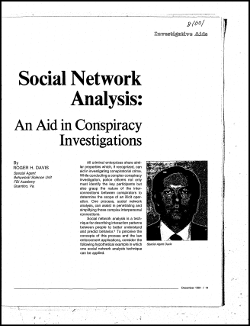
Social network analysis is a technique for describing interaction patterns between people to better understand and predict behavior. The investigation of an organized fencing operation being run by members of a local gang from a tavern is an example of the potential use of this technique. In this hypothetical example, the police watch the tavern during the evening hours to determine who may be involved in the operation. Using social networking techniques, the officers can convert their observations of people arriving at and departing from the tavern into a network diagram showing the structure of interpersonal relations within the group. From this picture, police can determine the connections between group members and can focus on those who would potentially be the most knowledgeable about the crime. Group structure may be important to investigations of racketeering enterprises, narcotics operations, illegal gambling, and business frauds. By examining network members' roles, relationships, and personalities, the investigator may identify the nature and extent of conspiratorial involvement. Either manual or computer techniques may be required to analyze the data. Among areas that may be analyzed are the social distance between individuals and groups, the direction in which exchanges flow between people, the relative influence of various group members, the suspect's centrality to the group, and the degree of cohesiveness of the group. Principles of network analysis may also be used to examine connections among groups. Network analysis is thus an important part of a conspiracy investigation and should not be overlooked as an investigative tool.
